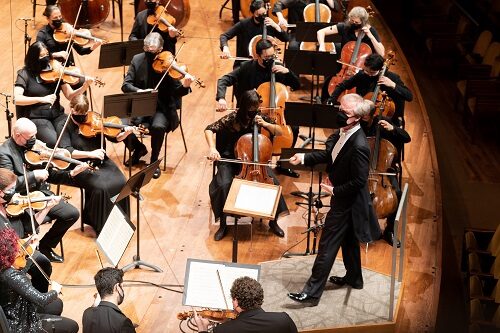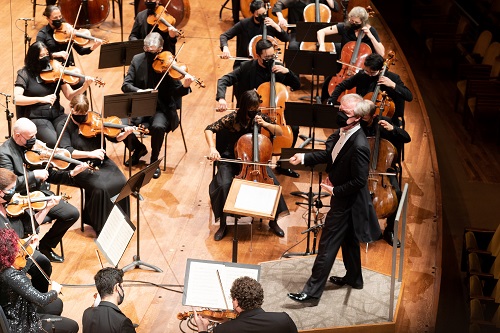 United States Dietterich, Ives, Schumann: Seattle Symphony Orchestra / David Robertson (conductor). Benaroya Hall, Seattle, 23.9.2021. (ZC)
United States Dietterich, Ives, Schumann: Seattle Symphony Orchestra / David Robertson (conductor). Benaroya Hall, Seattle, 23.9.2021. (ZC)

Natalie Dietterich – aeolian dust
Ives – Three Places in New England
Schumann – Symphony No.3 in E flat major Op.97, ‘Rhenish’
It took more than a year, but music with a live audience is back at Benaroya Hall. Yes, last weekend was the Seattle Symphony’s community concert and, technically, that concert marked the return of music. But this week saw the triumphant return of the symphony’s subscription concerts. David Robertson was at the podium for the weekend’s performances, and he organized a program that featured Schumann’s ‘Rhenish’ Symphony, the original orchestration of Charles Ives’ Three Places in New England and a newer work – aeolian dust – by American composer Natalie Dietterich.
To facilitate the orchestra’s return to performing in front of live audiences, the Seattle Symphony and Benaroya Hall are strictly but seamlessly adhering to masking and vaccine protocols. At the entrance, employees speedily checked IDs and vaccine cards (keeping yours on an app like NYC COVID Safe makes the process even faster). For the moment, food and drink services in the hall are suspended, which ensures that people keep their masks on. Though others may not yet be ready to venture out for live performances, I felt that I was in a safe pair of hands attending this concert in Benaroya Hall.
In the program notes, Robertson described the concert as an exploration of place: each piece describes a different musical landscape. Schumann is in Düsseldorf and on the Rhine with flowing melodies and vivid soundscapes. Ives brings New England to life with three tone poems that are revolutionary for their time, but also nostalgic in the way American tunes are used, with musical ideas layered like a collage. The piece challenges listeners to focus not just on the snippets of melodies but also on the way they relate to one another. Perhaps the most interesting of all, Dietterich’s aeolian dust calls to mind a type of aural landscape, similar to works by John Luther Adams that the Seattle Symphony has premiered over the years.
Schumann’s melodies sprang forth with life while the brass fanfares in the fourth movement glowed, and Robertson’s attentive direction helped smooth out the composer’s occasionally awkward transitions. In a similar way, detailed playing from the orchestra’s sections ensured Ives’s complex layers were perceptible to the listener, sparing the audience the type of cacophonous delivery that a less skilled orchestra might deliver. Even the pulsing fragments of aeolian dust came alive in a seemingly effortless way, making a strong case both for the orchestra’s finesse and Dietterich’s gifts as a composer.
The 2021 subscription season is off to a strong start. With COVID-19 still spreading unchecked in places, the pandemic could keep large audiences away for some time, but I hope this isn’t the case. Strict safety protocols are in place here, and the Seattle Symphony will be doing its best to bring world-class live music to Benaroya Hall.
Zach Carstensen
